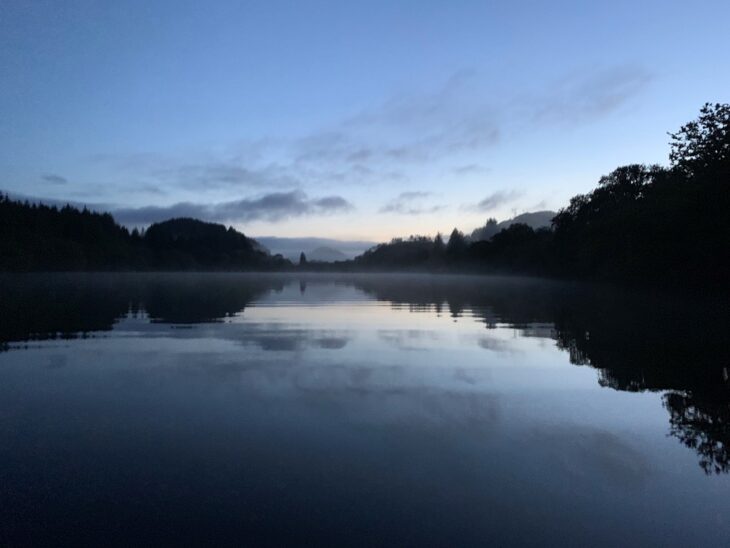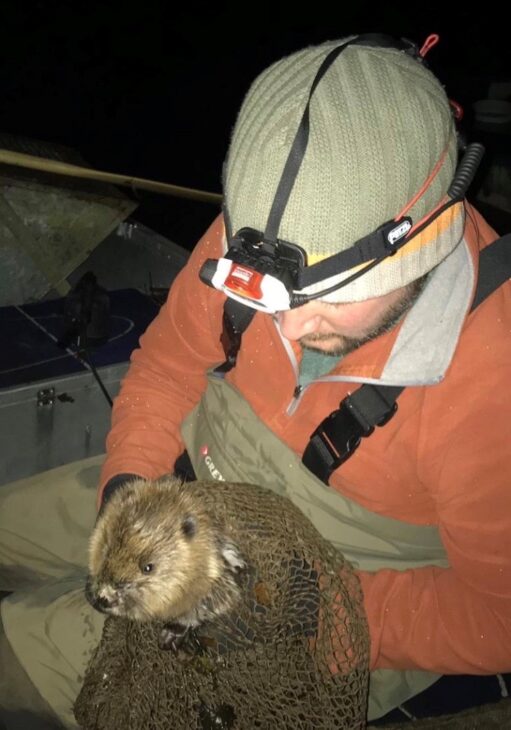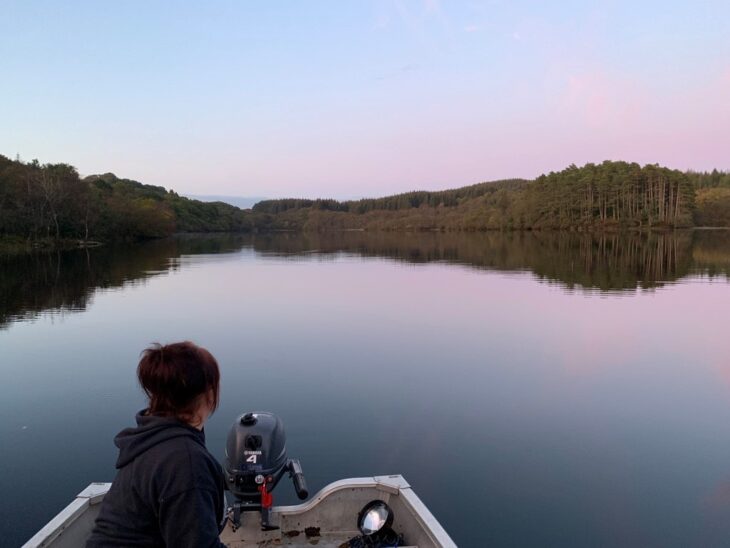Catching beavers in Knapdale Forest
In this guest blog Róisin Campbell-Palmer, beaver fieldworker and former Field Operations Manager with the Scottish Beaver Trial details what’s involved in catching beavers to check on their health and condition.
Knapdale is a special place. Yes it’s often wet and grey, but when the sun shines and the winds are still, it can feel pretty magical.

Rob Needham and I spent many years there in our respective roles for the Scottish Beaver Trial, as Field Officer and Field Operations Manager. So, it was with genuine excitement and interest that we returned to Knapdale to assist the Scottish Beavers partnership late last year.
One of our main, and perhaps most enjoyable, roles during SBT itself was monitoring the beavers, observing their activities and their changes to the environment. Being able to watch secretive behaviours from afar on a canoe or through an appropriately placed camera trap gave us a glimpse of a beaver’s perspective of the world and each of their individual characteristics.
The main aim of our trip this time was to trap and assess the beavers that are now present in Knapdale, a number of generations on from the original animals we brought over from Norway in 2009. These animals have been joined by others which have been translocated through the Scottish Beavers Reinforcement Project, both from captive bred origins and from the Tayside catchment as part of NatureScot’s Beaver Mitigation Scheme.
We had two weeks to collect samples for health and genetic studies, along with assessing body condition, determining familial relationships and tagging as many new individuals as possible. We used a combination of Bavarian live cage and boat trapping techniques in order to fulfil these objectives, working closely alongside the veterinary and conservation teams from the Royal Zoological Society of Scotland.
We were incredibly lucky with the weather, with barely a midge in sight! The still waters of the lochs certainly brought back many happy memories of time spent previously following the family dynamics of the originally released animals.
A familiar face
While many animals were new to us, several familiar and welcome faces appeared. One of these was Bjornar, a strong character who we were pleased to find was still holding the territory of Loch Collie Bharr. Bjornar was originally trapped in Norway alongside his mate Katrina and their two offspring and all brought to Scotland. He was a fine figure of a beaver, coming into his prime at the time of the Trial. This family quickly established themselves in the wilds of the west coast, an area much rainier than Norway but rich with good beaver habitat.
Bjornar stands out as one of the memorable personalities mainly because he was next to impossible to catch as part of the annual health check-ups. Time and time again, he ignored traps set with food which other members of his family found irresistible – his then partner Katrina, for example, showed no fear or opposition to almost nightly cage trapping for a free meal. On being let out again in the early hours of the morning she would agreeably plod away and slip back into the water, only to reappear, with everything eaten in the following days.
Bjornar, on the other hand, was having none of it. Perhaps some of the most comical camera trap footage recorded shows him staring into a baited trap for several minutes at a time, looking almost transfixed at the food inside, but knowing far better than to cross over the line. We eventually managed to re-trap him at the very end of the five-year Scottish Beaver Trial project. But only once.
When we returned to Knapdale this time we caught up with a grizzlier Bjornar, slightly greyer around the muzzle but just as in charge of his loch. This time he readily sat and watched us as we passed on the boat, and let us observe in ease him going about his nightly business. He was non-plussed by our presence and even regularly entered the cage traps for a meal and plodded off again as we released him.
A game of beaver and mouse
With the sun setting over the Hebrides, and the calm loch mirroring the sky, we got ready for some boat trapping on the Knapdale lochs. It had been five years since Rob and I had last trapped here together, but it was like riding a bike.
Live beaver capture involves a lot of kit. We had our head torches, spot lights, batteries, two different types of nets (a jumping net and a scoop net) and all the other paraphernalia required for a night’s work. The outboard engine and fuel levels were checked, and the nets and equipment were secured. We were ready.
As we pulled away from the jetty the night was bursting with nostalgia and anticipation. Our spotlights scanned the water for any tell-tale signs of beaver presence. Some of these are obvious – a beaver sat on the bank or swimming along the loch shore – but some are more subtle, such as water rippling against the wind direction and suspicious line of bubbles under the surface.
It was not long before we spotted our first beaver, a young kit. We headed slowly towards it, with our net at the ready. Before we could get within 30 metres the youngster dived. The engine slipped into neutral while we scanned the loch for its reappearance. Then we saw it heading from the middle of the loch to the shoreline. The engine hopped into gear as we attempted to get between the kit and the shore. It was working… we managed to get in front of it and we were in a position where it was swimming straight towards us.
Slipping the engine into neutral to minimise disturbance, we waited on the port side for the beaver which was swimming straight towards us. When it was a metre away it sensed the boat, and dived. We had anticipated its movements and down went the net in front of the kit. A few minutes later, safely bundled in the net, a beaver kit sat quietly on the floor of the boat. We covered it in a light blanket to keep it dark and calm as we took it to the nearest shore to carry out our checks.

Once we have a beaver safely secured in the handling sack, the real science begins. The beavers are taken back to shore. Every animal is weighed, measured and microchipped (if one not already present), to enable individuals to be recognised. Individuals which are large enough are also ear tagged, this allows us to recognise them through binoculars without the need for consistent recapture.
The vet undertakes a thorough examination of the beaver, looking at the overall health of the individual. A small faecal and blood sample is then taken to look for potential pathogens and genetic provenance, before the animal is released back to the area where it was captured. It is a genuine honour to be so hands on with a mammal that was once extinct in Scotland.
The game of cat and mouse continued for the rest of the trip, some nights being more fruitful than others. Overall it was a very successful trip with a number of new individuals captured and microchipped, adding to the ever-growing data set collated through the Scottish Beavers project.
A final thought
Since the early days of the Scottish Beaver Trial a lot has moved on in the story of beaver restoration to Britain. Beavers have become a European Protected Species in Scotland, while England has several reintroduction projects including on the River Otter in Devon, and Wales is in the process of developing its own trial.

Though beavers can cause conflicts with some land-use practices especially in heavily modified landscapes, the science strongly demonstrates they are a force for good – increasing biodiversity, creating and improving wetlands, quietly carrying out a range of ecological services from water storage, nutrient cycling and sediment trapping. Society will only realise these benefits if we tolerate their activities and provide appropriate and reactive management and mitigation options in the areas where they are challenging to live with.
Help protect Scotland’s wildlife
Our work to save Scotland’s wildlife is made possible thanks to the generosity of our members and supporters.
Join today from just £3 a month to help protect the species you love.
Preface
In this guest blog Róisin Campbell-Palmer, beaver fieldworker and former Field Operations Manager with the Scottish Beaver Trial details what’s involved in catching beavers to check on their health and …
